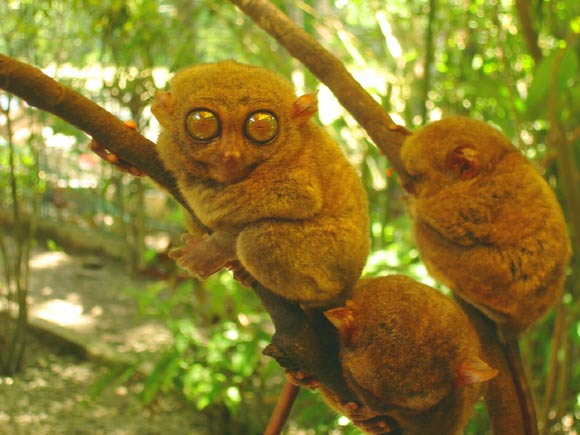An international team of researchers from the United States and Germany today reports having sequenced and annotated the genome of the Philippine tarsier. The team’s results place tarsiers on an important branch of the primate evolutionary tree — along the same branch that leads to humans, monkeys and great apes.
Tarsiers belong to the 45-million-year-old family Tarsiidae. They are small nocturnal primates that were, together with their presumed sister family, the extinct Omomyidae, once widespread in Asia, Europe and North America, but today populate only insular Southeast Asia.
The tarsier family contains at least 10 extant species that are found in the Indonesian and Malaysian parts of Borneo, the Indonesian islands Sulawesi, Sumatra and Java as well as Greater Mindanao and surrounding islands of the southern Philippines.
Tarsiers are arboreal primates characterized by large eyes and ears. Their legs and feet are adapted for sudden, powerful leaps, with an elongated ankle bone, the tarsus, for which they are named. These anatomical specializations allow tarsiers to effectively detect and pounce on prey items.
While tarsiers, the world’s most carnivorous primates, are generally insectivorous throughout their geographic range, some were observed feeding on small birds, rodents and lizards.
This diet requires highly specialized optic and auditory adaptations for detecting insect motion and capturing cryptic prey. For example, tarsier eyes comprise a mass that is nearly twice the mass of their brain, and the morphology of the skull reflects the modifications necessary to support a pair of hypertrophic eyes.
The position of tarsiers among primates has been considered controversial.
Their teeth and jaws are more similar to ‘wet-nosed’ primates such as lemurs, but their eyes and noses are more similar to ‘dry-nosed’ primates such as monkeys and humans.
By sequencing the complete genome of the Philippine tarsier (Tarsius syrichta), a species of tarsier endemic to the Philippines, the research team led by Washington University School of Medicine scientist Wesley Warren definitively placed tarsiers in the dry-nosed category.
“We sequenced the tarsier not only to determine where they fit in primate evolution, but because their physiology, anatomy and feeding behavior are very unique,” Dr. Warren said.
The team analyzed DNA sequences known as transposons, or ‘jumping genes,’ which can jump from one part of the genome to another, often duplicating themselves in the process. Over time, transposons lose the ability to jump.
The scientists compared the transposon families of tarsiers, humans, bushbabies (a wet-nosed primate) and squirrel monkeys (a dry-nosed primate). Tarsiers shared more recent transposon families with squirrel monkeys and humans, and only the oldest ones with bushbabies, indicating that tarsiers belong with the dry-nosed primates.
“By analyzing the jumping elements, we can learn so much about our own evolution. These jumping genes are DNA sections that can copy themselves and take up new positions in the genome,” said study lead author Dr. Jürgen Schmitz, from the University of Münster in Germany.
“As in humans, these jumping genes make up around half of the genetic material in tarsiers. Thanks to the availability of the tarsier genome, it was possible to detect integrations of jumping genes that dates way back.”
Having the complete tarsier genome also allowed the team to study the genes that make tarsiers unique.
By comparing gene sequences from tarsiers with those from other primates, the researchers identified 192 genes that are changing faster or slower than what is happening in other primates. These genes likely are linked to the tarsiers’ unusual traits.
The team then scanned the scientific literature to identify human diseases associated with those genes and found 47 diseases. About a quarter were related to vision and another quarter to musculoskeletal problems.
“The tarsier genes that display unique alterations can give us a clue into human diseases involving the same genes,” Dr. Warren said.
“If an amino acid has been uniquely changed and it is putatively associated with the tarsier’s novel musculature, maybe it’s an important part of the protein and worthy of a closer look when linked to human disease.”
Analysis of the tarsier genome also showed that these animals are displaying signs of population decline.
“We think the population size is declining and not rebounding. Most of the decline is due to loss of habitat, but the pet trade also is contributing,” Dr. Warren said.
The researchers are hoping to obtain DNA from other tarsier species and populations, which they plan to use to assess the health of the tarsier population, among other studies.
“If we can sequence the genome of other tarsiers, we can measure the population diversity. A population with a greater amount of diversity should be more capable of surviving changes in its environment,” Dr. Warren said.
“It will help us determine how endangered they really are so we can implement measures to better protect them.”
The research was published online today in the journal Nature Communications.
_____
Jürgen Schmitz et al. 2016. Genome sequence of the basal haplorrhine primate Tarsius syrichta reveals unusual insertions. Nature Communications 7, article number: 12997; doi: 10.1038/ncomms12997








